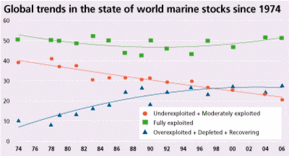 National fishery authorities and the fishing industry need to do more to prepare for and adapt to the impacts of climate change, according to the latest, 2008, edition of the UN Food and Agriculture Organization’s State of World Fisheries and Aquaculture.
National fishery authorities and the fishing industry need to do more to prepare for and adapt to the impacts of climate change, according to the latest, 2008, edition of the UN Food and Agriculture Organization’s State of World Fisheries and Aquaculture.
Existing implementation of responsible fishing practices needs to be expanded, as do strategies for coping with climate change, according to the report, which was released on Monday. “Best practices that are already on the books but not always implemented offer clear, established tools towards making fisheries more resilient to climate change,” Kevern Cochrane, one of SOFIA’s authors, stated.
“So the message to fishers and fisheries authorities is clear: get in line with current best practices, like those contained in FAO’s Code of Conduct for Responsible Fisheries, and you’ve already taken important strides towards mitigating the effects of climate change.”
World Fisheries Production Reaches New High as Over-exploitation Increases
Aquaculture now accounts for a record-high 47% of world fisheries production, which reached a record high of 143.6 million metric tons in 2006, according to the SOFIA report. Of the total, 110.4 million metric tons was used for human consumption. The rest was used for livestock feed and fishmeal for aquaculture.
Nineteen percent of major commercial marine fish stocks monitored by the FAO are ‘overexploited,’ 8% are depleted and 1% are considered as ‘recovering from depletion,’ according to the FAO.
More than half, 52%, of the commercial marine fish stocks monitored by the FAO are considered ‘fully exploited,’ where catches are close to their maximum sustainable limits. Twenty percent are categorized as “moderately exploited” or “underexploited.”
The Northeast Atlantic, Western Indian and Northwest Pacific Oceans have the highest proportions of fully exploited stocks.
Changing Habitats, Seasonal Patterns & Productivity
A changing climate is already shifting the distribution of marine and freshwater species. Warmer water species are migrating towards the poles where they’re experiencing changes in habitat size and productivity, the report says. The seasonality of biological processes is also changing, bringing with it marine and freshwater food webs. The unpredictable consequences pose serious challenges to local fishing communities’ livelihoods.
“Many fisheries are being exploited at the top range of their productive capacity. When you look at the impacts that climate change might have on ocean ecosystems, that raises concerns as to how they’ll hold up,” Cochrane said. “Urgent efforts are needed to help fishery and aquaculture dependent communities to strengthen their resilience to climate change, especially those most vulnerable,” he added.
Seafood and Emissions
The globalization of seafood markets — in which fresh catches are quickly transported from fishing vessels to processing centers and shipped to overseas markets — makes fishing and aquaculture energy intensive industries, with resulting high levels of CO2 and greenhouse gas emissions.
The average ratio of fuel to carbon dioxide emissions for capture fisheries is estimated at 3 teragrams of CO2 per million metric tons of fuel used, according to the report. That could be improved, according to Cochrane.
“Good fisheries management can substantially improve fuel efficiency for the sector. Overcapacity and excess fishing capacity mean fewer fish caught per vessel—that is, lower fuel efficiency—while competition for limited resources means fishers are always looking to increase engine power, which also lowers efficiency.”
Transporting seafood by air adds significantly to the total. “Compared to actual fishing operations, emissions per kilogram of post-harvest aquatic products transported by air are quite high, SOFIA adds. Intercontinental airfreight emits 8.5 kg of CO2 per kilogram of fish transported. This is about 3.5 times that for sea freight and more than 90 times that from local transportation of fish where it is consumed within 400 kilometers of catch.”


